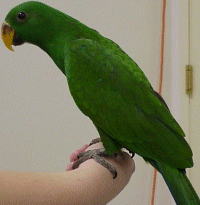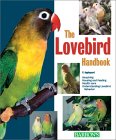Eclectus Parrots
The name Eclectus is derived from the word eclectic because of the sexually dimorphic coloration of the male and female. The males are varying shades of green depending upon their subspecies, and have brilliant red splashes of color on their wing bends and sides. From the age of about one year, they have a striking candy corn beak. The females are varying shades of red, blue, lavender, and purple. The females of the Vosmaeri subspecies have an additional daisy yellow color on the tail. All adult females have jet black beaks. Because of the pronunciation of the word eclectic, many people pronounce the name of the Eclectus parrot “e-cleck-tus.” Photos below show an eclectus female (left) and male (right).
Origin: Eight to ten subspecies of Eclectus are recognized. They originated from the Cape York Peninsula of Australia, the islands of Indonesia, the Solomon Islands, and New Guinea. Only a few of these subspecies are commonly available in aviculture. They are the Grand, Red Sided, Vosmaeri , and Solomon Island subspecies.
Talking ability:Eclectus parrots are generally classified among the top three parrots for talking ability. Rivaling the African Grey and the talking Amazon parrots in clarity of speech and scope of vocabulary, they not only repeat many words and phrases but some learn entire songs. My oldest male sings “You ain’t Nuthin’ but a Hound Dog” from start to finish! Some Eclectus chicks learn their first word before they are weaned if the hand-feeder repeats a word to them often. Eclectus parrots enjoy repeating interesting sounds as well as words and phrases learned from their human companions. Many Eclectus owners have been fooled by phantom doorbells, running water, and family members talking in absentia. Some males have melodious voices while others sound more masculine, but nearly all Eclectus females have the most charming sweet and seductive voice–full and throaty like that of a “southern belle opera singer.” As with all parrot species, there are birds that never learn to say more than “hello”.
Housing: The answer to the question of proper cage size for the Eclectus parrot is easy; buy the largest cage or aviary that your space and budget will accommodate. Horizontal space is important due to the large wingspan of the Eclectus. They require daily exercise and their cage must be wide enough to allow them to flap their wings vigorously if they are unable to fly in the home or in a large aviary. Three feet is a good width if they are to spend a good deal of time in the cage. Cage height is important because of their love of climbing. A macaw-style cage allows enough vertical space for a boing toy to be hung inside the cage. Otherwise, a four or five foot cotton rope and a swing are standard Eclectus cage equipment. They enjoy small hand toys, V-Tech brand and other toys for toddlers, and any challenging toy that can be manipulated by beak and feet. Wood toys for chewing and destruction can prevent a bird from becoming interested in overgrooming and possibly destroying its feathers. Eclectus should be allowed out of the cage and into a separate play area or tree for at least an hour a day and longer if possible.
Diet: It has been reported that Eclectus have a longer than average intestinal tract to accommodate the high fiber diet that they require. They have been observed in the wild eating many types of fruits, flowers, and vegetable matter. The Eclectus digestive system seems to be extremely efficient at assimilating nutrients from foods. This probably is due to the high percentage of fibrous fruits and vegetables that make up their diet in the wild. These foods are “nutrient-sparse” foods as opposed to “nutrient-dense” foods such as pellets. Since they assimilate nutrients so efficiently, they can exhibit symptoms such as “repetitive foot clenching and wing flicking” if oversupplemented or fed too many rich foods. Unless a vitamin or mineral deficiency is diagnosed with blood tests, they should not be supplemented with vitamins and minerals. Even pellets which have a full complement of vitamins and minerals can be too rich for the Eclectus system. Natural juicy foods of deep color including greens, sprouts, fruits and vegetables should be the mainstay of their diet. They do not need vitamin A supplements or shots, as was thought many years ago. They will assimilate all the vitamin A that they need from the colorful orange, yellow, red, and green foods like pomegranates, mangos, cantaloupe, carrots, red and green bell peppers, kale, collards, dandelion and other greens. All parrots should be given organically grown produce whenever possible.
Health: Eclectus are hardy birds that have no species-specific health problems. They thrive on exercise, natural foods, and pure water. They need a wide variety of nutritious foods rather than vitamin and mineral supplements. Some of the neonates experience “constricted toe syndrome” which is a treatable problem. Being “Old World” birds, Eclectus have no natural resistance to the Sarcocystis falcatula disease that can be a problem in warm climates. This disease requires several intermediate hosts but basically starts with an infected grackle or cowbird eaten by an opossum that sheds the sporocysts in its feces, which then is carried to the parrot by cockroaches and certain flies. Old World parrots that are housed outside, or anywhere that cockroaches or flies are a problem, should have tightly screened habitats to avoid this almost always fatal disease.
Longevity: When Eclectus parrots were first imported into the United States, little was known of their nutritional requirements and many people tried to maintain them on an all-seed diet. Until their need for a variety of colorful, fibrous fruits and vegetables was known, many of them did not live for as long as they should have. Although one pamphlet is still distributed stating that the average life expectancy of the Eclectus is eight years, most people now realize that there is no reason that Eclectus parrots cannot live as long as other parrots their size, such as Amazons and African Greys. I personally know of one pair that is still producing at the age of thirty-plus years, so obviously thirty is NOT old age for an Eclectus. Because they have not been in this country for more than a few decades, there are few Eclectus over the age of thirty in captivity in the U. S., but they should be able to live for 50-75 years just as other parrots of comparable size.
Noise: In general, Eclectus are quiet birds that prefer talking to screaming, but there are exceptions to every rule and there are a few loud Eclectus. Because most of them are exceptionally quiet for large parrots, they are considered suitable for apartment living; however, if one should obtain one of the few exceptionally loud members of this species, that would not be the case. They are capable of very harsh, loud calls when threatened with danger. Fortunately, most of them do not use the warning call very often.
Sleep: Ten hours sleep is the general rule for Eclectus parrots, but if the family schedule does not allow for ten uninterrupted, quiet hours of sleep, they will make up the lost rest with cat naps during the day. If it is impossible to provide a dark and quiet place for sleep, covering the cage is an option. Young Eclectus fledglings play hard and sleep soundly in thirty to sixty minute increments throughout the day.









